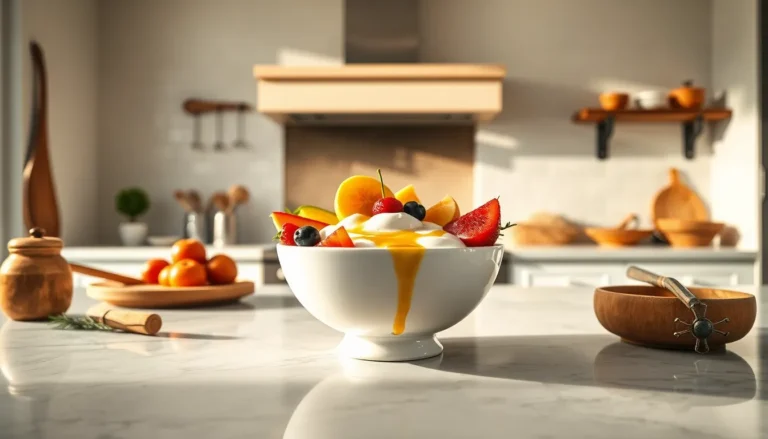Upgrading to laminate flooring might just be the best decision since someone invented sliced bread. Imagine transforming your space with a stylish, durable option that won’t break the bank or your back. Laminate flooring offers the look of hardwood without the high maintenance or price tag, making it the perfect choice for homeowners who want to impress without the stress.
Picture this: a sleek new floor that can handle everything from muddy paws to clumsy dance moves at your next family gathering. With a variety of designs and finishes, laminate flooring can fit any aesthetic, from cozy cottages to modern lofts. So why settle for dull, outdated floors when a simple upgrade can breathe new life into your home? Let’s dive into the world of laminate flooring and discover how this upgrade can elevate both style and functionality in any space.
Table of Contents
ToggleBenefits Of Laminate Flooring Upgrade
Upgrading to laminate flooring provides numerous advantages, making it an excellent choice for homeowners. Its combination of style, functionality, and affordability enhances living spaces significantly.
Cost Effectiveness
Laminate flooring excels in cost-effectiveness compared to traditional hardwood. Prices typically range from $1 to $5 per square foot, significantly lower than hardwood, which averages $5 to $10. Savings accumulate not only in material costs but also in installation expenses. Many laminate options feature a click-lock installation system that simplifies DIY projects. Lower maintenance costs contribute further by reducing the need for expensive treatments. Homeowners enjoy an attractive look without compromising their budgets.
Durability And Longevity
Durability stands out as a key benefit of laminate flooring. Most laminate products resist scratches, dents, and fading, making them ideal for households with kids and pets. The protective layer ensures they maintain their appearance even under heavy foot traffic. Average lifespan ranges from 15 to 25 years, depending on quality and care. Homeowners find that laminate flooring withstands moisture better than hardwood, which is prone to warping and mildew. For those seeking reliable longevity, upgrading to laminate offers peace of mind.
Types Of Laminate Flooring
Laminate flooring offers diverse styles to suit any home. Homeowners can explore various types based on design preferences and sustainability.
Modern Designs
Modern laminate flooring features innovative patterns and textures. Distressed wood looks provide a contemporary vibe while maintaining an authentic feel. Options include sleek finishes and high-gloss surfaces, reflecting current design trends. Additionally, unique stone and tile effects serve homeowners wanting to achieve a sophisticated aesthetic without the high cost of real materials. The versatility in colors caters to diverse interior styles, allowing easy integration into both minimalist and eclectic designs.
Eco-Friendly Options
Eco-friendly laminate flooring options emerge as homeowners prioritize sustainability. Many brands utilize recycled materials, reducing environmental impact during production. Look for laminate certified by organizations like the Forest Stewardship Council, ensuring responsible sourcing. Some products feature low VOC emissions, promoting better indoor air quality. Additionally, the longevity of laminate contributes to its sustainability, as longer-lasting floors mean less frequent replacement. Choosing eco-friendly laminate supports a healthier home and environment without sacrificing style.
Installation Process
Installing laminate flooring involves several key steps that ensure a seamless and effective upgrade. Homeowners can choose between DIY methods or hiring professionals based on their comfort level and project complexity.
DIY Vs. Professional Installation
Selecting between DIY and professional installation depends on skill level and project size. DIY is cost-effective, requiring minimal tools and skills for those comfortable with home improvement. Professionals offer expertise and efficiency, especially for larger spaces or complicated layouts. Hiring experts often guarantees a quicker installation, providing peace of mind. It’s essential to consider the time commitment involved; experienced workers complete projects faster, ensuring less disruption.
Tools And Materials Needed
Gathering the right tools and materials is crucial for a successful installation. Essential tools include a tape measure, saw for cutting planks, and a hammer for flooring adjustments. Homeowners also need spacers, underlayment for cushioning, and a tapping block to secure planks. Materials should consist of the selected laminate flooring, underlayment, and any transition strips that fit the surrounding areas. Having everything ready before starting ensures a smooth installation process. Planning properly minimizes interruptions and enhances the overall outcome.
Maintenance Tips For Laminate Flooring
Cleaning laminate flooring involves a few simple steps. Start by sweeping or vacuuming to remove dirt and debris. Use a soft cloth or mop dampened with water and a mild cleaner specific for laminate. Avoid soaking the flooring, as excess water can damage the planks.
Scratches can happen, but they’re often minimal. Applying a laminate flooring repair kit helps cover them effectively. Many homeowners find this an easy solution to maintain their floor’s appearance.
Spills should be cleaned immediately to prevent damage. Blot the area with a soft cloth instead of rubbing it, which can spread the liquid. Common household items like vinegar mixed with water can work for stubborn stains.
To keep laminate looking fresh, avoid harsh chemicals. Strong cleaners can cause deterioration over time. Select products labeled safe for laminate to ensure longevity.
Furniture pads under legs can prevent scratches. Many homeowners forget this simple precaution, yet it significantly reduces wear. Additionally, limit direct sunlight to prevent fading, using window treatments when necessary.
Seasonal changes in humidity affect laminate as well. Maintaining indoor humidity levels between 30 and 50 percent supports stability. Using a dehumidifier or humidifier proportionally can manage fluctuations.
Regular inspections allow early identification of potential issues. Check for gaps between planks or signs of water damage. Once identified, addressing these concerns quickly maintains overall integrity.
Following these maintenance tips ensures laminate flooring continues to provide style and durability for years.
Conclusion
Upgrading to laminate flooring is a smart choice for homeowners looking to elevate their spaces. Its blend of style durability and affordability makes it an appealing option. With various designs available and easy installation methods homeowners can transform their interiors without hassle.
The long-lasting nature of laminate flooring combined with its resistance to wear and moisture ensures it remains a practical solution for busy lifestyles. Regular maintenance is straightforward allowing homeowners to enjoy their beautiful floors for years to come. Embracing laminate flooring not only enhances aesthetics but also supports sustainability making it a responsible choice for modern living.


